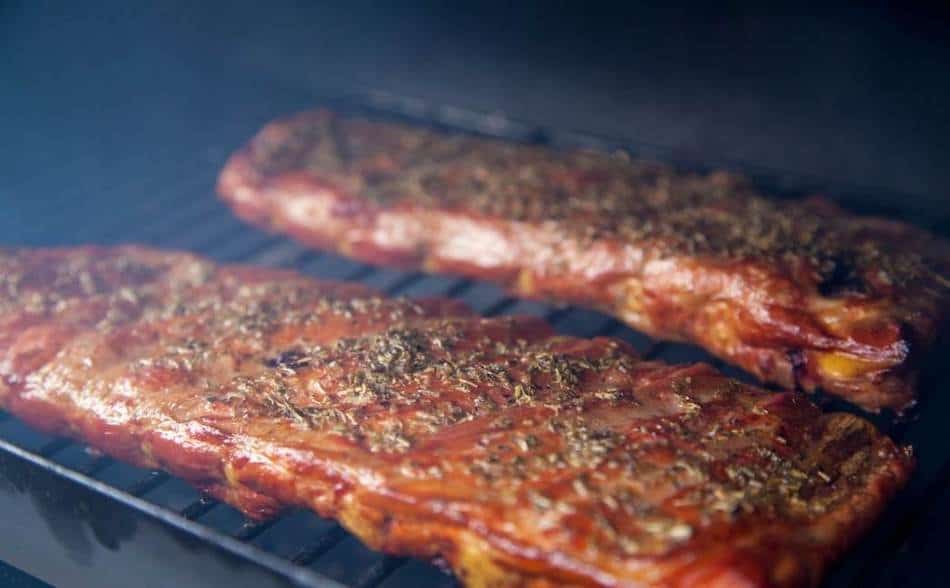
Trying to figure out the right time to pull your ribs off the smoker can be tricky because there’s so much to consider. Temperature is only a guide. You should also perform a series of tenderness tests to determine if your ribs are cooked perfectly. I asked some of the world’s best pitmasters when they remove ribs from the smoker.
The ideal temperature for smoked ribs is between 190°F and 205°F. However, each rack is different so always perform a tenderness test. There are several methods that pitmasters and barbecue experts use to determine when ribs are tender. These include the bend test, using a toothpick or small knife to probe between the bones, and checking the internal temperature with a meat thermometer. It’s important to remember that ribs need time to break down the connective tissues, resulting in tender, juicy meat, so plan on smoking them for at least six hours. With these tips in mind, you’ll be well on your way to producing perfectly cooked ribs every time.
What the Experts Say
Smoking ribs is a true test of a pitmaster’s skills, and knowing when they are done is crucial for producing tender, juicy meat with a smoky flavor. There are several methods that barbecue experts and pitmasters use to determine when ribs are fully cooked and ready to be served.
One method is the “bend test,” where the pitmaster gently grabs the bone in the center of the rack with tongs and gives it a gentle bend. If the meat cracks and starts to pull away from the bone, the ribs are done. If they bend too easily and the meat tears, they need more time. If they’re tough and resist bending, they’re overcooked. As competitive barbecue pitmaster Myron Mixon says, “If you can cook a rack of ribs and have them fall off the bone, you can cook anything.”
Another way to test for doneness is with a toothpick or small knife. As Chris Lilly, a competitive barbecue pitmaster and author, advises, “The ribs are done when the probe slides in with just a little resistance.” BBQ expert Meathead Goldwyn recommends using a meat thermometer as well, noting that ribs are done when they reach an internal temperature of 190-205°F. At this temperature, the collagen in the ribs will have broken down and the meat will be tender and easy to pull off the bone.
Pitmaster and owner of BBQ Dave’s in Indiana, Dave Anderson, also advises using a meat thermometer to ensure that ribs are fully cooked. However, pitmaster Tuffy Stone prefers the “bend and snap” test, where the pitmaster gently grabs the middle of the rack with tongs and gives it a slight bend. If the rack cracks and starts to break, the ribs are done. If it’s still too tough and doesn’t want to break, it needs more time.
It’s important to note that ribs need time to break down the connective tissues, which results in tender, juicy meat. As Aaron Franklin, owner of Franklin Barbecue and author of “Franklin Barbecue: A Meat-Smoking Manifesto,” points out, “The old saying goes, ‘You can’t rush good barbecue.’ And when it comes to smoking ribs, this is especially true. Ribs need time to break down the connective tissues, which results in tender, juicy meat. Plan on smoking ribs for at least 6 hours, and as long as 12 hours.”
Why is 203°F is The Magic Number?
The USDA recommends cooking ribs to a safe internal temperature of 145°F, however, the meat would be far too tough if you were to serve ribs at this temperature. As with brisket, meat that contains a lot of connective tissue needs time at low temperatures in order to break down and tenderize. When testing your ribs for tenderness, go by feel rather than temperature. However, you will find ribs will reach perfect tenderness at around 203°F, although it may vary between ribs.
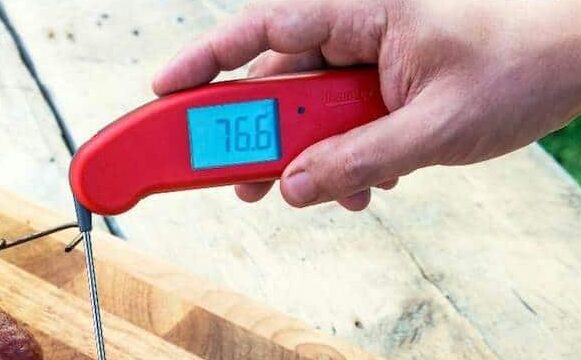
The Rib Bend Test
The most common tenderness test for ribs is the bend test. This involves bending the rib rack, and learning how to feel what the perfectly cooked ribs should feel like. If the ribs have reached doneness, it should feel as though you could rip the ribs in half. When cracks emerge in the meat, that means the ribs are getting close. If the ribs bend all the way without snapping or cracking, then they need longer.
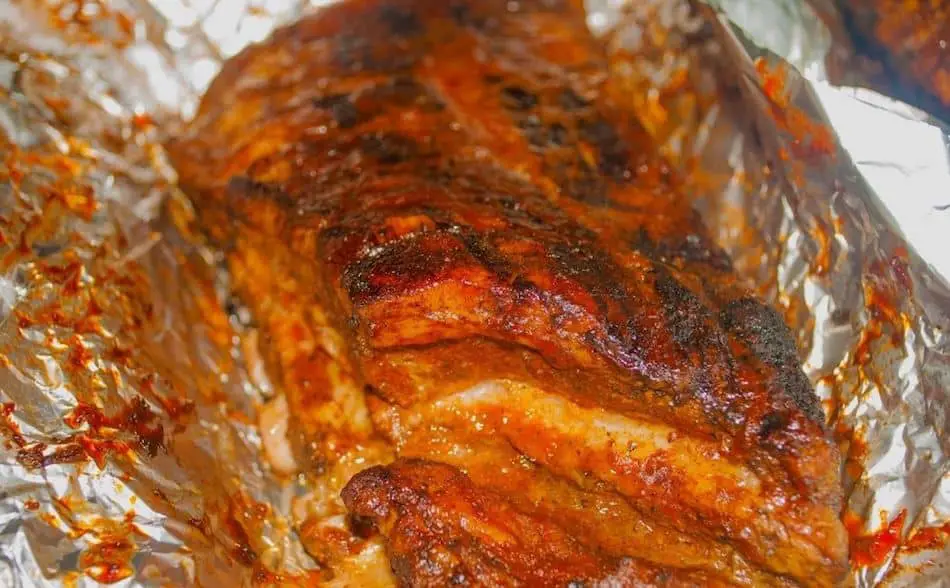
“When To Sauce Ribs? We Asked The Pitmasters”
The Rib Bone Twist Test
Another tenderness test is to twist one of the bones. When the meat has reached ideal tenderness, it should feel as though you could twist the bone and the meat could come off. However, you don’t want ribs so tender that the meat falls off the bone. Chewing meat from the bone is one of the most enjoyable parts of the experience.
The Toothpick Test
Another common rib tenderness test involves sticking a toothpick into the meat between the ribs. When ribs have reached ideal tenderness, there should be no resistance when you insert the toothpick, and it will feel as though you are poking the toothpick into a stick of butter. Ribs often have thicker parts of the slab, so make sure you poke different areas of the ribs. Instead of a toothpick, you can also use an instant-read thermometer probe to test for tenderness while also observing the temperature reading.
How Long Does It Take To Smoke Pork Ribs?
It takes about 6 hours to smoke a rack of spare ribs or St. Louis cut ribs. Baby backs contain a thick layer of lean, tender meat, so it should take an hour or two faster than spare ribs. However, the total cook time depends on the temperature you are cooking, and the thickness of the pork ribs. If you’re cooking at 275° F, the ribs may be done in around 4 hours. If you are following the 3-2-1 method, and cooking at 225° F, it should take about 6 hours.
Have you tried smoking a Wagyu brisket yet? You can get one delivered to your door from Snake River Farms.
What’s The Best Temperature For Smoking Ribs?
You can smoke ribs either at 225° F, right up to 275° F. Stick within this range, and you shouldn’t have a problem. Don’t go below 200°F because this will put the meat into the “danger zone” and potentially put the health of you and your family at risk. At the other end of the spectrum, if you cook above 275° F, the ribs may dry out or burn.
Does The 3-2-1 Method Overcook Ribs?
The 3-2-1 method is a very popular technique for smoking ribs, however, most professionals do not follow this method. The 3-2-1 method involves cooking the ribs for 3 hours unwrapped, 2 hours wrapped, then 1 hour unwrapped with barbecue sauce. Many pitmasters say the 3-2-1 method overcooks ribs, causing them to become dry or overly tender. Most professionals will smoke ribs using a technique similar to a 2-2-1 method, but most pitmasters make decisions based on the look and feel of the ribs rather than a set timeframe. The 3-2-1 method is a good framework for beginners, but I would recommend learning how to go by look and feel as soon as possible.
The 3-2-1 vs 2-2-1 Ribs
The 2-2-1 method is similar to the 3-2-1, except you are smoking for 2 hours unwrapped, 2 hours wrapped, and 1 hour with a sauce. The 2 hours is the ideal time to let your ribs sit on the smoker absorbing smoke, where is 3 might be too long. If I had preferred method, I would choose the 2-2-1 method. Although pitmasters like Aaron Franklin and Malcolm Reed don’t follow these methods, the 2-2-1 is probably closest to what these barbecue gurus practice.
Competition Ribs Internal Temp
Most barbecue competitors will test their ribs for tenderness rather than internal temperature. However, perfect tenderness for smoked ribs should occur around about the 200° F range. Perform the tenderness test by bending the ribs in the middle, or poking with a toothpick or a thermometer.
Smoked Baby Back Ribs Internal Temperature
Cook baby back ribs until they reach an internal temperature between 190°F and 203°F. Since baby backs contain a thick layer of lean meat, they will cook faster than spare ribs. As with all types of ribs, performing a tenderness test is the most accurate method for measuring doneness. Over time, you will learn to go more by feel rather than testing meat temperature. The bend test, the twist test and the toothpick test are all suitable for baby back ribs.
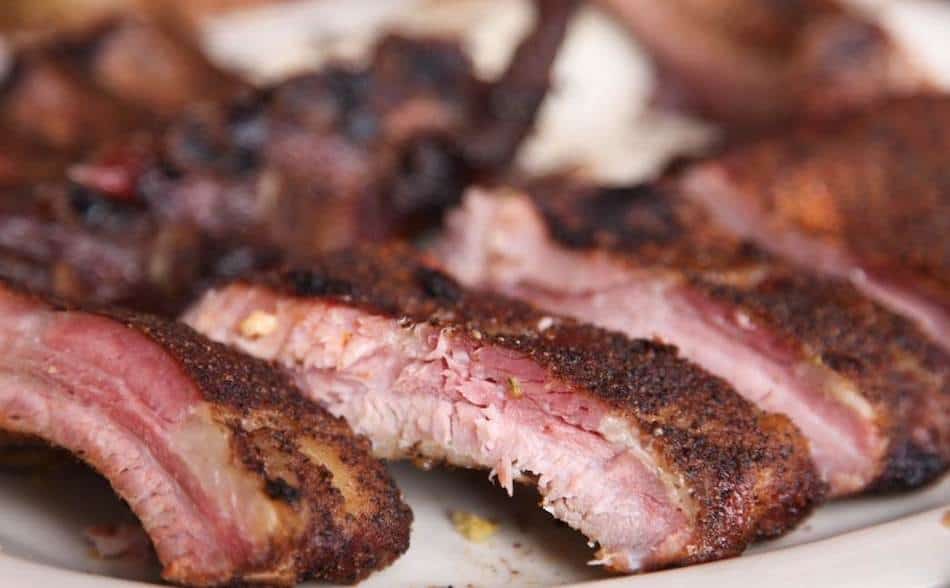
How To Reheat Ribs – The Best Way To Restore Leftover Barbecue
3-2-1 Ribs Internal Temperature
When smoking ribs using the 3-2-1 method, remove ribs from the smoker once the internal temperature reaches around about 200° F. The 3-2-1 method can overcook the ribs, so don’t be afraid to pull them off early. As soon as the ribs hit that 200° F range, perform a series of tenderness tests.
This brisket injection marinade is the secret used in competitions and made by a World Barbecue champion.
Pork Ribs at 225°F
A cooking temperature of 225° F standard for low-and slow-smoking. It’s hard to mess up when smoking at this temperature, so it’s safe for beginners. If you need the ribs done faster, increase the temperature once you have wrapped the ribs in foil. However, you can also leave the ribs cooking low at 225° F for the entire cook, it will just take longer. Expect the ribs to take about 6 hours to cook at 225°F if you are following the 3-2-1 method of 3 hours unwrapped, 2 hours wrapped and one hour in sauce.
Pork Ribs at 250°F
The 250°F range is the ideal temperature for smoking ribs because anywhere between 225°F and 275°F is suitable. The ribs won’t dry out the ribs at 250°F, and they’ll be done faster than ribs cooked at 225°F. You can expect the ribs to be done in a little over 5 hours at this temperature, maybe a little over.
Pork Ribs at 275°F
Smoking ribs at 275° F is probably about as high as you want to go. I’ve seen Aaron Franklin cooking at this temperature, and the ribs turned out amazing. You will finish the ribs much sooner when cooking at 275° F. You could expect the ribs to be finished in a little over 4 hours. Obviously, you will need to monitor the ribs a little more carefully at a higher temperature, and you should rotate the ribs if you’re using a charcoal smoker. If you have a hot-zone and a cool-zone, keep rotating the ribs otherwise, you will get a lot of charring. Sometimes I will start off at 225° F, and once the ribs reach the wrapping stage, I will increase the temperature of my smoker to 275° F, just to get them done a sooner.
How Long To Rest Pork Ribs
Rest The pork ribs for about 30 minutes to an hour after smoking. This will give the meat time to reabsorb some of those juices. You can also place the ribs into holding as you would a brisket by placing them in a dry cooler. Leave them in their wrapping and the foil.
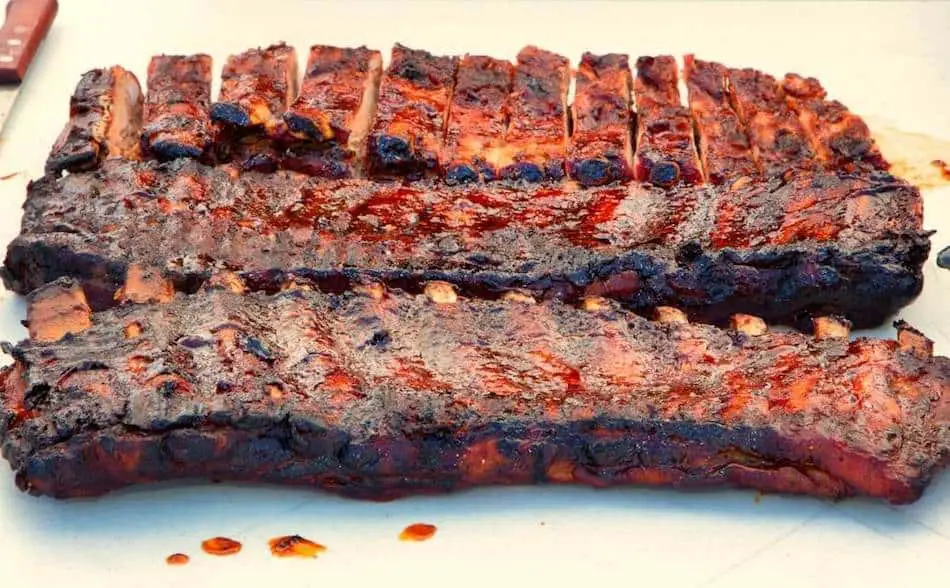
“Aaron Franklin Beef Ribs – The Full Recipe From The BBQ Guru”
How Does Aaron Franklin Smoke Ribs
I’ve watched Aaron Franklin smoke ribs several times, and he uses something similar to a 2-2-1 method. Aaron usually cooks at 275° F, and he uses an offset smoker and a mixture of hickory and cherry wood.
For preparation, Franklin uses a salt and pepper base (one part salt, two parts pepper) with some chilli flakes mixed in. He uses olive oil as a binder, then places a mixture of garlic powder, paprika, and onion powder into a shaker and covers the ribs.
For the first 2 hours, Aaron leaves the ribs untouched in the smoker. Once the ribs reach a nice mahogany color, he spritzes them with apple juice or water, then cooks the ribs for another 15 minutes. After spritzing the first time, Franklin spreads a barbecue sauce over the ribs, then cooks the meat for another 15 minutes to set the sauce. He then wraps the ribs in two layers of aluminium foil, applies more sauce, then tightly wraps the ribs and cooks for 2 more hours. He performs a tenderness test by poking the middle with a toothpick or doing the tenderness bend test.
Wrap Ribs In Foil or Paper
Aluminium foil is the most common way of wrapping ribs. However, paper is becoming a trend and is said to produce a better bark. As always, experiment with both and see what you like. Paper is more commonly used with brisket, however you can use with ribs.
Homemade Rub For Ribs
Standard Barbecue Rub

I found this great rub recipe through How To BBQ Right. I use this recipe and alter it slightly depending on what I'm cooking. Made by the guys at Townsend Spice & Supply: https://townsendspice.com/
Ingredients
- - ½ Cup Paprika
- - ½ Cup Salt
- - ½ Cup Sugar
- - ½ Cup Granulated Garlic
- - ¼ Cup Granulated Onion
- - ¼ Cup Chili
- - ¼ Cup Cumin
- - 2 Tablespoons Black Pepper
- - 2 Tablespoons Dry Mustard
- - 1 Tablespoon Cayenne Pepper
Instructions
- Combine all the spices together in a large mixing bowl
- Store rub in rub shakers
The Best Rubs On The Market
My Favorite Meat Smoking Tools
Thanks for checking out this article. I hope you learned a few things. Here are some of my favorite tools I use when smoking brisket that may be useful to you. These are affiliate links, so if you decide to purchase any of these products, I’ll earn a commission. But in all honesty, these are the tools I recommend to my family and friends who are just starting out.
Meat Thermometer: There are dozens of fancy thermometers on the market, but I still use my trusty TP20. For around $50, I have a high-quality meat thermometer with two probes, and can track the temperature of my smoker with one probe, and my meat with the other probe. The ThermoPro TP20 is an Amazon Best Seller because it’s the easiest thermometer to operate, is durable, highly accurate, and comes with pre-programmed meat settings.
Instant Read Thermometer: Arguably, the second most important tool you need is a fast and accurate instant-read thermometer. These tools play an important role in the latter stages of the cook when the meat needs regular checking in multiple areas. I use the ThermoPro TP19 because it can do everything a ThermaPen can do, but for a fraction of the cost. You can check out the TP19 on Amazon here.
Wireless Thermometer: The latest thermometers on the market have no wires and can be controlled by wi-fi via your phone. Airprobe 3 is the best of this technology.
Butcher Paper: Wrapping brisket in butcher paper has become a huge trend in barbeque thanks to Aaron Franklin. Wrapping your brisket in paper will give you a nice brisket bark. However, you can’t just use any old paper, it has to be unwaxed, food grade paper. You can find it on Amazon here.
Advanced Thermometer and Automatic Temperature Controller: Once you’re ready to take things seriously, the FireBoard 2 Drive is a six-channel Bluetooth/Wi-Fi thermometer that can monitor up to 6 pieces of meat, control and graph your cook sessions on your smartphone, and attaches to an an automatic blower that will convert your charcoal smoker to a set-and-forget. This is one of the most advanced meat thermometers on the market. You can check it out on the FireBoard website here.

